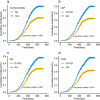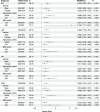Association between abdominal obesity indices and falls among older community-dwellers in Guangzhou, China: a prospective cohort study
- PMID: 39232713
- PMCID: PMC11373189
- DOI: 10.1186/s12877-024-05319-0
Association between abdominal obesity indices and falls among older community-dwellers in Guangzhou, China: a prospective cohort study
Abstract
Background: Central obesity was considered as a risk factor for falls among the older population. Waist circumference (WC), lipid accumulation product (LAP), visceral adiposity index (VAI), and the Chinese visceral adiposity index (CVAI) are considered as surrogate markers for abdominal fat deposition in increasing studies. Nevertheless, the longitudinal relationship between these indices and falls among the older population remains indistinct. This study aimed to explore the association between abdominal obesity indices and falls among older community-dwellers.
Methods: Our study included 3501 individuals aged ≥ 65 years from the Guangzhou Falls and Health Status Tracking Cohort at baseline in 2021 and then prospectively followed up in 2022. The outcome of interest was the occurrence of falls. The Kaplan-Meier curves and multivariable Cox regression analysis were used to explore the associations between abdominal obesity indices and falls. Moreover, the restricted cubic spline analysis (RCS) was conducted to test the non-linear relationships between abdominal obesity indices and hazards of falls incident.
Results: After a median follow-up period of 551 days, a total of 1022 participants experienced falls. The cumulative incidence rate of falls was observed to be higher among individuals with central obesity and those falling within the fourth quartile (Q4) of LAP, VAI, and CVAI. Participants with central obesity and those in Q4 of LAP, VAI, and CVAI were associated with higher risk of falls, with hazard ratios (HRs) of 1.422 (HR 95%CI: 1.255-1.611), 1.346 (1.176-1.541), 1.270 (1.108-1.457), 1.322 (1.154-1.514), respectively. Each 1-SD increment in WC, LAP, VAI, and CVAI was a significant increased risk of falls among participants. Subgroup analysis further revealed these results were basically stable and appeared to be significantly stronger among those females, aged 65-69 years, and with body mass index (BMI) ≥ 28 kg/m2. Additionally, RCS curves showed an overall upward trend in the risk of falls as the abdominal indices increased.
Conclusions: Abdominal obesity indices, as WC, LAP, VAI, and CVAI were significantly associated with falls among older community-dwellers. Reduction of abdominal obesity indices might be suggested as the strategy of falls prevention.
Keywords: Abdominal obesity indices; Cohort study; Falls; Older population.
© 2024. The Author(s).
Conflict of interest statement
The authors declare no competing interests.
Figures




Similar articles
-
Association of Visceral Obesity Indices With Incident Diabetic Retinopathy in Patients With Diabetes: Prospective Cohort Study.JMIR Public Health Surveill. 2024 Feb 6;10:e48120. doi: 10.2196/48120. JMIR Public Health Surveill. 2024. PMID: 38319705 Free PMC article.
-
Association between abdominal obesity indices and risk of cardiovascular events in Chinese populations with type 2 diabetes: a prospective cohort study.Cardiovasc Diabetol. 2022 Nov 1;21(1):225. doi: 10.1186/s12933-022-01670-x. Cardiovasc Diabetol. 2022. PMID: 36320060 Free PMC article.
-
The Chinese visceral adiposity index: a novel indicator more closely related to cardiovascular disease than other abdominal obesity indices among postmenopausal women.J Transl Med. 2024 Sep 23;22(1):855. doi: 10.1186/s12967-024-05665-y. J Transl Med. 2024. PMID: 39313824 Free PMC article.
-
Visceral adiposity and inflammatory bowel disease.Int J Colorectal Dis. 2021 Nov;36(11):2305-2319. doi: 10.1007/s00384-021-03968-w. Epub 2021 Jun 9. Int J Colorectal Dis. 2021. PMID: 34104989 Review.
-
Evolving perspectives on evaluating obesity: from traditional methods to cutting-edge techniques.Ann Med. 2025 Dec;57(1):2472856. doi: 10.1080/07853890.2025.2472856. Epub 2025 Mar 12. Ann Med. 2025. PMID: 40077889 Free PMC article. Review.
References
-
- WHO, Aging. oveview. Available online at: https://www.who.int/health-topics/ageing#tab=tab_1
-
- National Statistical Bureau of the People’s Republic of China. Statistical Bulletin of National Economic and Social Development for 2023. Available online at: https://www.stats.gov.cn/sj/zxfb/202402/t20240228_1947915.html
-
- WHO. Step safely: strategies for preventing and managing Falls across the life course. Geneva: World Health Organization; 2021.
-
- Vos T, Lim SS, Abbafati C, Abbas KM, Abbasi M, Abbasifard M, Abbasi-Kangevari M, Abbastabar H, Abd-Allah F, Abdelalim A, et al. Global burden of 369 diseases and injuries in 204 countries and territories, 1990–2019: a systematic analysis for the global burden of Disease Study 2019. Lancet (London England). 2020;396(10258):1204–22. 10.1016/S0140-6736(20)30925-9 - DOI - PMC - PubMed
MeSH terms
Grants and funding
LinkOut - more resources
Full Text Sources
Medical
Research Materials

